Have you ever felt left out at a gathering because you can’t enjoy the treats? This feeling sparked my interest in gluten-free baking. I’ve been perfecting the Easy Gluten Free Vanilla Cupcakes recipe since 2010.
After many attempts, I’m excited to share a simple recipe that makes delicious bakery-style cupcakes. Pair these cupcakes with our Healthy Chocolate Banana Bread for a wholesome treat, or serve them alongside our Gluten-Free Cinnamon Roll Wreath for an elegant brunch spread. For an extra indulgence, top them with frosting made from our Easy Gluten-Free Cookie Dough. Let’s make every bite of these cupcakes a joyful experience, no matter your dietary needs.”
Table of contents
- Introduction to Gluten Free Baking
- What Makes These Cupcakes Special
- Key Ingredients for Gluten Free Vanilla Cupcakes
- Tips for Choosing the Best Gluten-Free Flour
- Step-by-Step Guide to Making the Gluten Free Cupcakes
- Achieving the Perfect Texture
- Frosting Your Gluten Free Vanilla Cupcakes
- Common Baking Mistakes to Avoid
- Storage Tips for Gluten Free Cupcakes
- Serving Suggestions for Your Cupcakes
- Why You Should Try Making Your Own Cupcakes
- Conclusion
- FAQ
Introduction to Gluten Free Baking
Gluten Free Baking has become very popular. This is because more people are looking for healthier food options. They want tasty treats that don’t have gluten.
At first, finding the right gluten-free flours can be confusing. You might see names like Bob’s Red Mill Gluten-Free 1-to-1 Baking Flour or Doves Farm Freee Gluten-Free Plain White Flour. But learning about these ingredients can make baking fun.
When making a cupcake, you want it to taste and feel like a regular one. Gluten-free flours soak up more liquid, making the batter wetter. This might need a short rest before baking.
To get the right texture, add xanthan gum or psyllium husk. These help the gluten-free mix act like gluten.
Choosing the right ingredients is key in gluten-free baking. Using single-origin flours like almond or coconut adds flavor and texture. Also, picking certified gluten-free ingredients is important to avoid cross-contamination.
Baking gluten-free might seem hard, but it’s doable. With the right steps and ingredients, you can make desserts that everyone will love. This cupcake recipe is perfect for both experienced bakers and beginners, ensuring great results every time.
What Makes These Cupcakes Special
The Unique Cupcake Recipe for gluten-free vanilla cupcakes is loved for its rich vanilla bean flavor and soft texture. Many bakers enjoy this recipe as a tasty treat that doesn’t skimp on quality. It’s a hit, with over 5.1K shares and a 4.98 out of 5 rating from 41 votes. This shows it’s one of the top gluten-free cupcakes out there.
What makes this recipe special is the choice of ingredients. Full-fat coconut milk and gluten-free self-raising flour make the cupcakes moist. It’s important to follow the recipe closely. Using a kitchen scale helps, especially with gluten-free flours.
These cupcakes make a dozen, great for any celebration or a sweet treat. Baking them takes 18-21 minutes. Make sure to fill the liners right to avoid spills. These steps make baking and enjoying these cupcakes at home a joy.
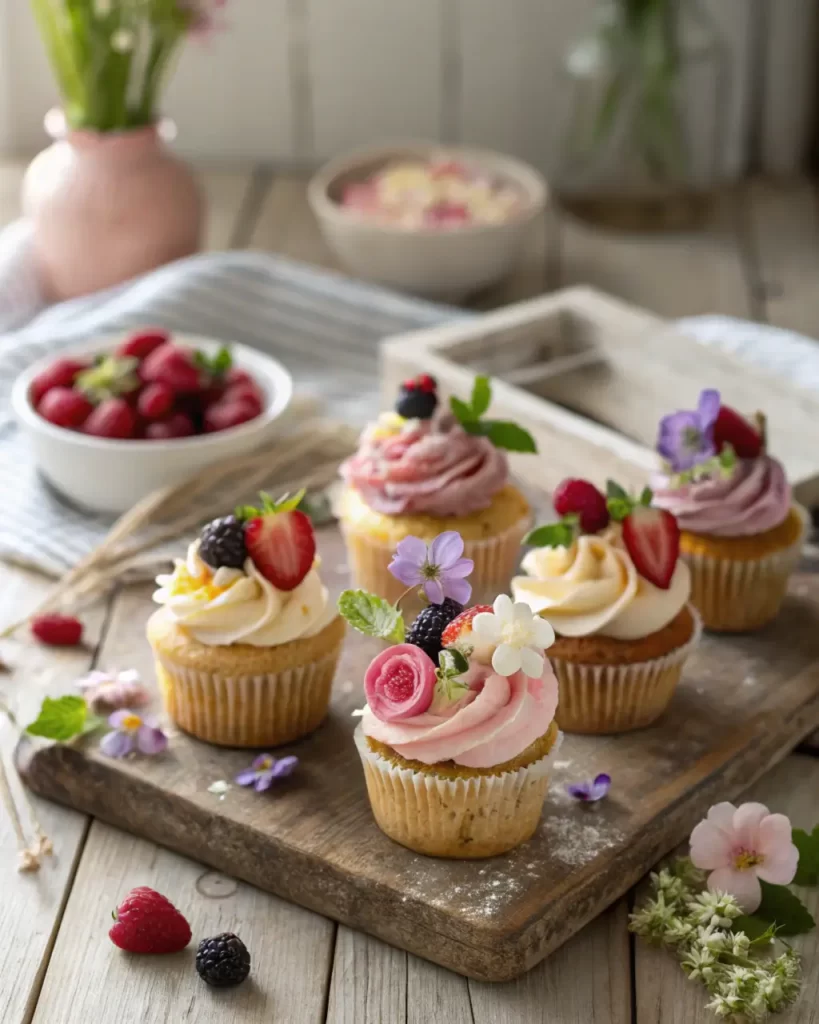
Key Ingredients for Gluten Free Vanilla Cupcakes
Baking gluten-free vanilla cupcakes requires the right ingredients. Each part adds to the taste, texture, and structure of your cupcakes. Let’s look at the dry and wet ingredients that make your cupcakes special.
Essential Dry Ingredients
Choosing the right Gluten Free Flour is key for the perfect texture. Look for brands like:
- Bob’s Red Mill 1:1 Gluten Free Baking Flour
- King Arthur Gluten-Free Measure for Measure Flour
- Cup4Cup Gluten-Free Flour
You’ll also need baking powder, baking soda, and a bit of salt. These add flavor and texture. They help your cupcakes rise and feel right.
Wet Ingredients and Their Importance
For wet ingredients, use fresh eggs and dairy-free milk like soy milk. Soy milk adds moisture and helps with structure. Don’t forget to add pure vanilla extract for a deep flavor. Together, these ingredients make your Cupcake Ingredients come alive.
By mixing these ingredients carefully, you’ll make gluten-free vanilla cupcakes that everyone will love.
Tips for Choosing the Best Gluten-Free Flour
Choosing the right gluten-free flour can make a big difference in your baking. There are three main types: designated gluten-free flours, gluten-free replacement flours, and naturally gluten-free flours. Each type has its own special qualities that can affect your baked goods.
Designated gluten-free flours are made for baking without gluten. They include Gluten-Free All-Purpose Flour and Gluten-Free ’00’ Pizza Flour. These flours have extra ingredients to replace wheat flour’s properties. If you want a flour that’s similar to regular flour, gluten-free replacement flours like Gluten-Free Measure for Measure Flour are great.
Naturally gluten-free flours like almond flour and oat flour are also good. They have unique tastes and textures. Always choose high-quality brands like Pillsbury for the best results.
Xanthan gum is important in gluten-free flour blends. It helps with texture and binding. Some flours have enough xanthan gum, but you might need to add more. Using the ‘spoon and level’ method helps with measuring.
For the best gluten-free baking, use tested recipes. This is especially important if you’re gluten-free. Also, be careful about cross-contact with gluten.
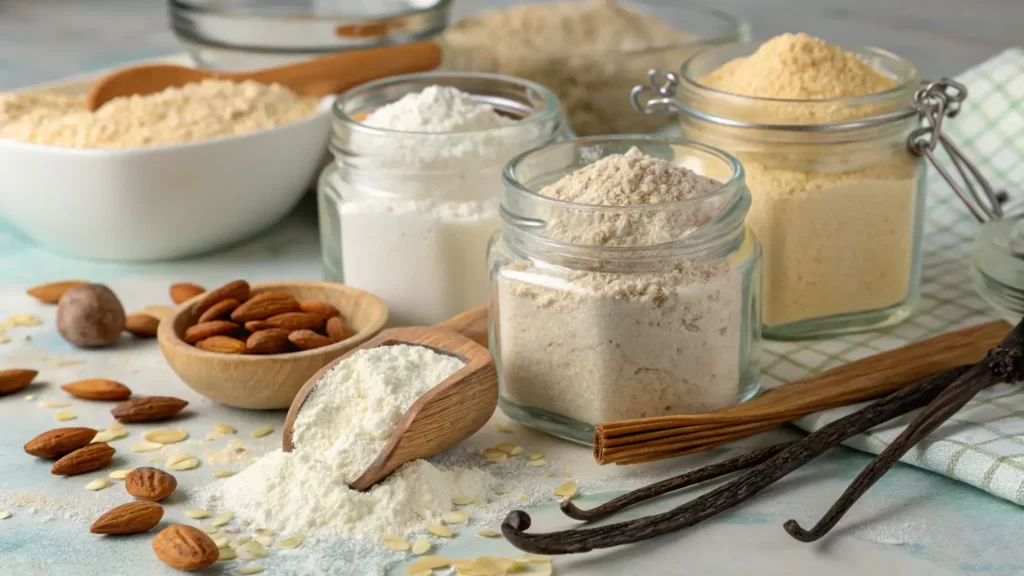
With these tips, you can make amazing gluten-free vanilla cupcakes and more. Knowing the differences between flour types helps you make a variety of tasty baked goods.
Step-by-Step Guide to Making the Gluten Free Cupcakes
Making gluten-free vanilla cupcakes needs careful steps. This guide will help you with Baking Steps and Cupcake Preparation. Your treats will be sure to delight.
Prepping Your Kitchen and Tools
First, gather all the tools you need. Make sure you have:
- A mixing bowl
- Measuring scales for precise ingredient measurement
- Quality gluten-free flour, like Cup4Cup
- Measuring cups and spoons
- Piping bags for frosting
Ensure all ingredients are at room temperature. This is especially true for butter and eggs. Melt the butter and let it cool a bit before mixing. Fill your cupcake liners about ⅔ full for even tops. For a domed top, fill them up to ¾ full.
Mixing the Batter Properly
Mixing the batter right is key for light cupcakes. Mix dry ingredients in one bowl until well combined. In another, mix wet ingredients with cooled melted butter. When combining, stir gently until just mixed. Avoid over-mixing to prevent dense cupcakes.
Bake at 350ºF for 18-20 minutes. Let them cool in pans for 5 minutes before cooling on a wire rack. Remember, you can store them in an airtight container or freeze for up to 3 months. Preparing and baking takes about 25 minutes, plus 20 minutes of prep.
Achieving the Perfect Texture
When baking gluten-free cupcakes, getting the right texture is key. You want them to be moist and fluffy. This can be hard without traditional flour. Knowing some baking tricks can really help.
Using different flours is common in gluten-free baking. A mix of all-purpose gluten-free flour and almond flour works best. This mix gives structure and makes the cupcakes light and airy. It’s important to measure your ingredients right, as small mistakes can change the moisture.
Room temperature ingredients are very important. Letting your fats and eggs get to room temperature helps the batter mix better. This makes the cupcakes moist and fluffy. When mixing, be gentle but thorough. Too much mixing can make the cupcakes dense, while not enough can leave them dry.
Baking time is also crucial. Gluten-free cupcakes should bake for 17 to 19 minutes at 350°F. This ensures they rise right and stay moist. Watch them closely towards the end; a toothpick should come out clean when they’re done.
Cooling your cupcakes right is the last step for that perfect texture. Let them cool in the pan for a few minutes before moving them to a wire rack. This keeps them moist and lets air circulate, making them even better.
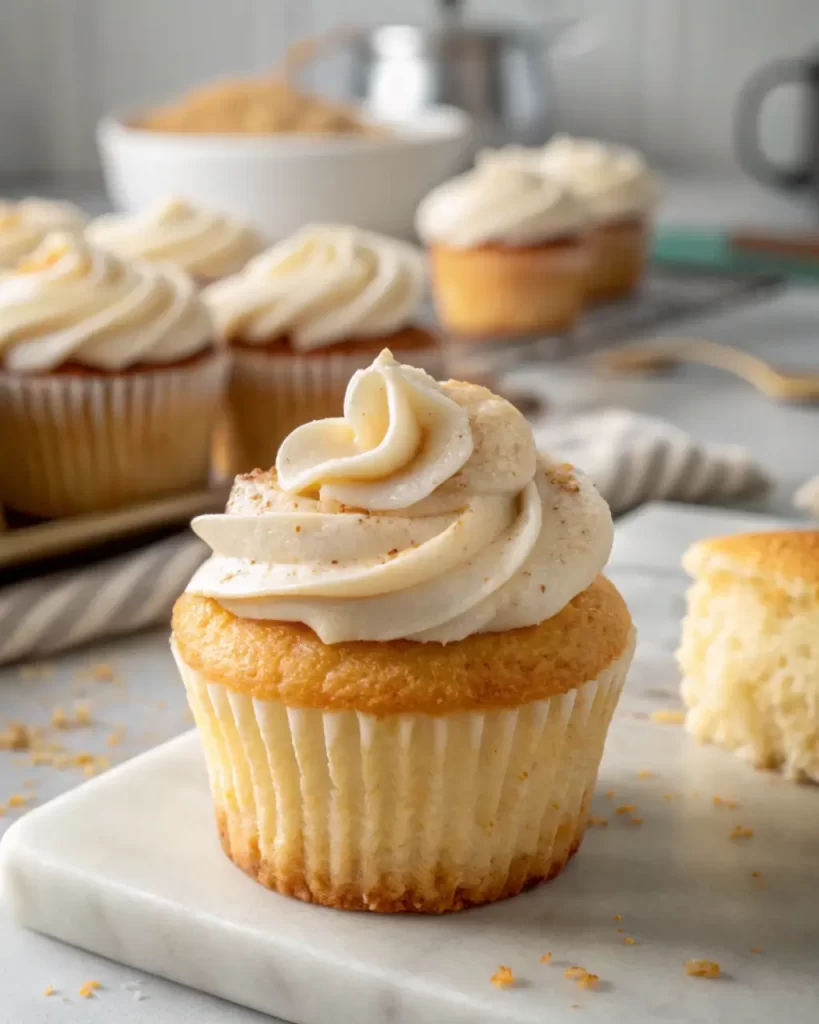
Frosting Your Gluten Free Vanilla Cupcakes
Frosting is key to making your gluten-free vanilla cupcakes taste great and look good. Choosing the right frosting can make a big difference. Whether you like Vanilla Buttercream or a dairy-free option, the right frosting changes the taste and feel.
Choosing the Right Frosting Type
Think about the flavor and dietary needs when picking a frosting. There are many types, each with its own special qualities:
- Vanilla Buttercream: This classic choice adds a rich, creamy texture that matches the sweetness of gluten-free cupcakes.
- Whipped Cream Frosting: It’s light and airy, offering a cool contrast to your vanilla cupcakes.
- Dairy-Free Frosting: Great for those with dietary restrictions, frostings made with coconut cream or nut butters are tasty and safe.
Making the Frosting from Scratch
Making Vanilla Buttercream from scratch is easy and rewarding. Here’s a simple recipe for the perfect frosting:
- In a medium bowl, beat 1 cup of softened unsalted butter until it’s creamy.
- Slowly add 3 cups of confectioner’s sugar, mixing well.
- Pour in 2 tablespoons of milk to get the right consistency.
- Keep mixing until it’s light and fluffy, about 3 to 5 minutes.
This Vanilla Buttercream is perfect with gluten-free cupcakes. For a special touch, add natural food colorings or sprinkles.
Common Baking Mistakes to Avoid
Baking gluten-free cupcakes can be a fun experience. But, many common mistakes can ruin your results. Knowing these errors is key to making perfect cupcakes. Here are some important tips to help you avoid these mistakes:
- Room temperature ingredients: Make sure your ingredients are at room temperature. This makes the batter smoother and helps it rise better.
- Preheating your oven: Always preheat your oven for 15 to 30 minutes before baking. This step is crucial for even baking and rise.
- Filling cupcake liners: Only fill liners two-thirds full to avoid overflowing or collapsing. This small change can make a big difference.
- Baking time: Bake your cupcakes for about 15 to 18 minutes. This time helps get the perfect texture.
- Handling baking powder: It’s important to measure baking powder accurately. Using expired baking powder or mixing it up with baking soda can mess up your cupcakes. Always sift it for even mixing.
- Overmixing and baking immediately: Overmixing can make your cupcakes dense. Mix just until combined and bake right away for the best rise.
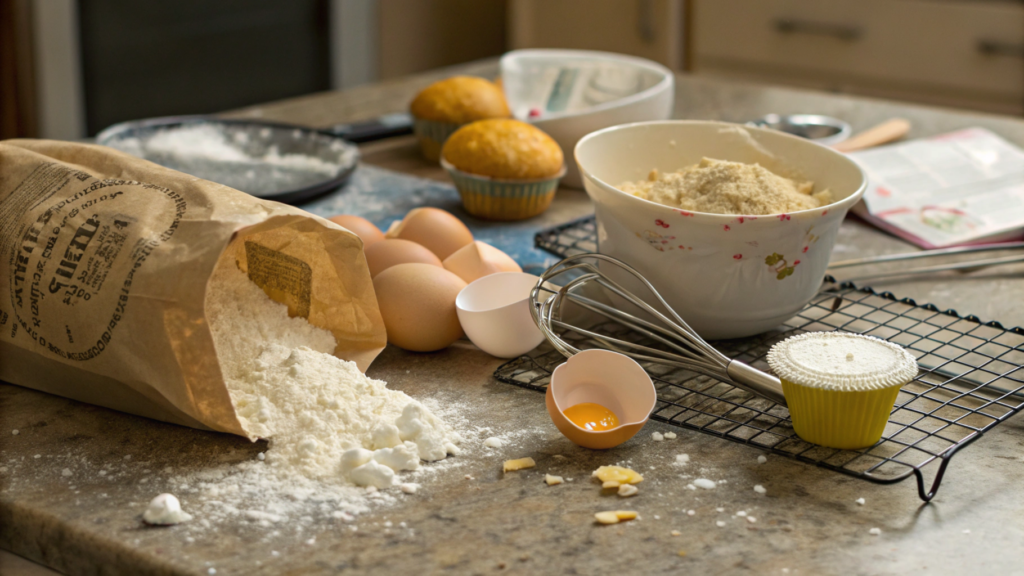
Knowing these common baking mistakes can boost your gluten-free baking skills. By following these tips, you can make cupcakes that look great and taste amazing.
Storage Tips for Gluten Free Cupcakes
To keep your gluten-free vanilla cupcakes fresh, proper Cupcake Storage is key. Store them at room temperature for up to 48 hours. This way, you can show them off on a cake stand and still enjoy their taste.
If you need to keep them longer, refrigerate your cupcakes. In an airtight container, they stay fresh for about 5 days. Ensure the container is sealed tightly to prevent moisture loss, which can dry out the cupcakes.
For even longer storage, Freezing Cupcakes is a great choice. Use airtight containers that are safe for the freezer. Your cupcakes can last up to 3 months. Wrap each one individually to protect against freezer burn. To thaw, place them in the fridge overnight or let them come to room temperature.
By following these tips, you can enjoy your gluten-free cupcakes for days. Keeping a close eye on storage conditions ensures every bite is as good as the first.
Serving Suggestions for Your Cupcakes
There’s more to serving cupcakes than just baking. You can make serving them special with the right drinks and decorations. These ideas will make your cupcakes unforgettable for any event.
Pairing with Beverages
Choosing the right drink to go with your cupcakes can make them taste even better. Here are some great options:
- Coffee: A dark brew pairs well with sweet cupcakes.
- Tea: Herbal or green tea offers a nice contrast to sweet flavors.
- Milk: It’s a classic choice that makes gluten-free treats even better.
- Fresh Juices: Citrus juices can balance out the sweetness nicely.
Decorative Ideas for Special Occasions
Decorating your cupcakes right can make them memorable. Here are some ideas:
- Seasonal Themes: Use holiday colors like red and green for Christmas or pastels for spring.
- Edible Flowers: Add edible flowers for a touch of elegance and color.
- Sprinkles: Colorful sprinkles add fun, especially for birthdays.
- Themed Toppers: Use toppers that match the event, like wedding or baby shower decorations.
Whether you choose classic drinks or stunning decorations, these tips will make serving cupcakes special. They’ll impress your guests and make every bite a joy.
Why You Should Try Making Your Own Cupcakes
Baking your own treats, like homemade cupcakes, does more than just satisfy your sweet tooth. It offers many benefits of baking that go beyond the kitchen. You can customize flavors and make dietary changes, giving your treats a personal touch that store-bought ones can’t.
Making something from scratch is incredibly rewarding. You know exactly what goes into your cupcakes, making sure they match your taste and dietary needs. You can use gluten-free flour or substitute eggs with chia seeds, making your treats fit anyone’s needs.
- Freshness: Homemade cupcakes are always at their best.
- Cost-Effectiveness: Baking at home is often cheaper than buying treats.
- A Sense of Accomplishment: Seeing and tasting your hard work is a joy.
Plus, homemade cupcakes usually taste better. You can cut down on sugar or use healthier options, making every bite enjoyable and guilt-free. Baking at home not only adds a personal touch but also improves your cooking skills and creates memories with family and friends.
Conclusion
In this Gluten Free Cupcake Recap, we’ve shown how important quality ingredients and techniques are. Using 1 ½ cups of gluten-free flour and 1 teaspoon of vanilla extract makes your cupcakes special. Don’t forget 1 ½ teaspoons of baking powder and the right mixing for a fluffy texture.
Making gluten-free vanilla cupcakes at home is truly rewarding. You can add your own flavors and decorations, making it a fun adventure. Whether you make mini cupcakes or use almond and coconut flour for a healthier option, you’ll learn a lot.
Now that you know the basics, it’s time to try this recipe and get creative. The kitchen is your playground, full of possibilities. Remember, gluten-free baking is all about exploring new flavors and ideas.
FAQ
Can I substitute all-purpose flour for gluten-free flour in this recipe?
No, using all-purpose flour will change the texture and taste of the cupcakes. It’s important to use gluten-free flour for the best results.
What brands of gluten-free flour do you recommend?
Bob’s Red Mill, King Arthur, and Pillsbury are top brands. Choose blends with xanthan gum for better texture.
How do I make these cupcakes dairy-free?
Use almond milk or coconut milk instead of regular milk. For frosting, pick dairy-free butter or coconut oil.
What is the best method for measuring gluten-free flour?
Use the ‘spoon and level’ method. Spoon flour into the measuring cup and level it off. This avoids packing and dense cupcakes.
How can I tell when the cupcakes are done baking?
Check with a toothpick. If it comes out clean or with a few moist crumbs, they’re ready. The tops should also spring back when pressed.
Can I freeze the cupcakes if I make a large batch?
Yes, you can freeze gluten-free vanilla cupcakes. Cool them completely, then store in an airtight container to prevent moisture loss.
What are some popular frosting options for gluten-free cupcakes?
Vanilla buttercream is a favorite. You can also try cream cheese frosting, whipped cream, or dairy-free frostings for different tastes.
Are there any common mistakes I should avoid when baking gluten-free cupcakes?
Yes, avoid overfilling the batter, incorrect measurements, and over-mixing. These can cause bad textures or flavors.
How should I store leftover gluten-free cupcakes?
Store them at room temperature in an airtight container for a few days. Refrigerate if you need to keep them fresh for a week. Freeze for longer storage.
Can I add additional flavors or ingredients to the cupcake batter?
Absolutely! Add chocolate chips, nuts, or citrus zest for extra flavor. Try different extracts like almond or orange too.
Print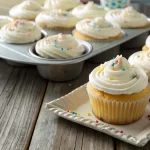
Gluten-Free Vanilla Cupcakes
- Total Time: 30 minute
- Yield: 12 cupcakes 1x
Description
Delightfully moist and fluffy gluten-free vanilla cupcakes with a rich vanilla bean flavor, perfect for any celebration or as a sweet treat.
Ingredients
- 1½ cups gluten-free self-raising flour
- 1 cup granulated sugar
- ½ teaspoon baking powder
- ½ teaspoon baking soda
- ½ teaspoon salt
- 2 large eggs, at room temperature
- ½ cup full-fat coconut milk
- ½ cup vegetable oil
- 2 teaspoons vanilla extract
- ½ cup hot water
Instructions
- Preheat Oven: Preheat your oven to 350°F (175°C). Line a 12-cup muffin tin with cupcake liners.
- Mix Dry Ingredients: In a large mixing bowl, whisk together the gluten-free self-raising flour, sugar, baking powder, baking soda, and salt until well combined.
- Combine Wet Ingredients: Add the eggs, coconut milk, vegetable oil, and vanilla extract to the dry ingredients. Mix until the batter is smooth and well combined.
- Add Hot Water: Gradually add the hot water to the batter, mixing continuously until fully incorporated. The batter will be thin, which is normal.
- Fill Cupcake Liners: Pour the batter evenly into the prepared cupcake liners, filling each about two-thirds full.
- Bake: Place the muffin tin in the preheated oven and bake for 18-21 minutes, or until a toothpick inserted into the center of a cupcake comes out clean.
- Cool: Remove the cupcakes from the oven and allow them to cool in the tin for 5 minutes before transferring them to a wire rack to cool completely.
Notes
- Flour Selection: For best results, use a high-quality gluten-free self-raising flour blend. If self-raising flour is not available, you can make your own by adding 1½ teaspoons of baking powder and ¼ teaspoon of salt per cup of gluten-free all-purpose flour.
- Dairy-Free Option: This recipe is naturally dairy-free when using coconut milk. Ensure all other ingredients are also dairy-free if you have dietary restrictions.
- Storage: Store cooled cupcakes in an airtight container at room temperature for up to 2 days, or refrigerate for up to 5 days. Unfrosted cupcakes can be frozen for up to 2 months; thaw at room temperature before frosting and serving.
- Prep Time: 15 minutes
- Cook Time: 18-21 minutes
- Category: Dessert
- Cuisine: American
Nutrition
- Calories: 210 kcal
- Fat: 10g
- Carbohydrates: 28g
- Protein: 3g





